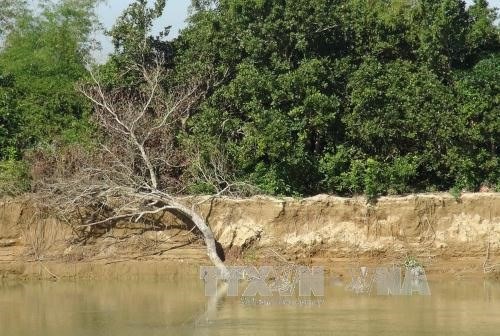Khanh Hoa: More than 25 million USD for flooding, erosion prevention
The central coastal province of Khanh Hoa plans to spend more than 580 billion VND (25.52 million USD) on 60 infrastructure projects to prevent flooding, river erosion and saltwater intrusion in 2017-2018.
 In Vinh Ngoc Commune, landslides and erosion have encroached upon some 20m of land, forcing some households to move to other places. (Photo: VNA)
In Vinh Ngoc Commune, landslides and erosion have encroached upon some 20m of land, forcing some households to move to other places. (Photo: VNA)Khanh Hoa (VNA) – The central coastal province of Khanh Hoa plans to spend more than 580 billion VND (25.52 million USD) on 60 infrastructure projects to prevent flooding, river erosion and saltwater intrusion in 2017-2018.
The investment includes more than 360 billion VND (15.84 million USD) sourced from state budget while the province and its districts will invest 99 billion VND (4.35 million USD) and 114 billion VND (5 million USD), respectively.
Erosion at the riverbank is endangering hundreds of households in Dien Khanh District and Nha Trang city. The most serious case is the riverbank along Cai River in four communes in Nha Trang city that needs almost half of the total investment, or 250 billion VND (11 million USD), to build embankments.
The erosion has affected 150 houses in which 600 people reside in Vinh Thanh Commune and more than 350 houses inhabited by 1,000 people in Vinh Trung, Vinh Phuong and Vinh Ngoc Communes.
It has also hit the banks of the Dau Stream in Dien Thanh Commune, the Cho River in Dien Xuan Commune, Dien Khanh District and the riverbanks of Lop River and Dinh River in Ninh Hoa town and Can River in Cam Ranh City.
It was estimated that floods at the end of 2016 caused landslides along 5.3 kilometres of riverbank in Khanh Hoa.
Lowlands in Cam Thinh Dong Commune, Cam Ranh City face serious flooding with water 0.5 – 1 metre deep in the wet season and saline intrusion in the dry season that affects up to 100 hectares of farm lands.
According to the provincial Department of Agriculture and Rural Development, the area is home to about 750 households with 3,000 people.
Some 100 billion VND will be used to build canals and dykes in Cam Thinh Dong while 70 billion VND will be spent to construct canals in Dien Dien and Dien Khanh Communes, Dien Khanh District to prevent saltwater intrusion.-VNA













